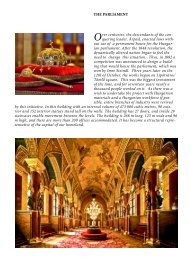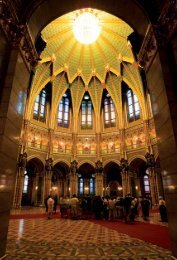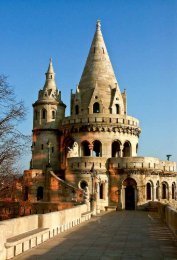Create successful ePaper yourself
Turn your PDF publications into a flip-book with our unique Google optimized e-Paper software.
GELLÉRT HILL<br />
Legend has it that this hill used to be a<br />
gathering place of witches, but today it<br />
is simply a place with a beautiful view of the<br />
city. The name of the hill is closely connected<br />
to another legend that tells the story of a<br />
bishop. His name was Gellért, and in 1046<br />
he visited the pagan Hungarians to convert<br />
them to Christianity, but they resisted, and<br />
the bishop was stuffed in a barrel equipped<br />
with inward pointing nails and rolled down<br />
a hill. Later, the converted Hungarians<br />
named the hill after Gellért and erected a<br />
statue depicting him. A university observatory<br />
was built atop the hill in 1815, but it did<br />
not last long. At the time of the war of independence<br />
in 1849, soldiers of the Hungarian<br />
army set up their artillery guns nearby and<br />
fired on Buda Castle from here. As a result<br />
of answering fire from the Austrian artillery,<br />
the Observatory was destroyed.<br />
The Citadel was raised on the site by the Habsburg<br />
dynasty in 1854. At 220 metres long with walls 12-16<br />
metres thick, this stronghold was built primarily for the<br />
purpose of intimidating the rebellious people of Pest, At<br />
the foot of the fortress wall overlooking the city, stands<br />
the Freedom Statue, which is the work of Zsigmond<br />
Strobl Kisfaludi. Today a hotel and restaurant are in<br />
operation within the thick walls. In 1987, UNESCO<br />
declared Gellért Hill as a world heritage site.<br />
39












